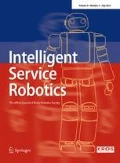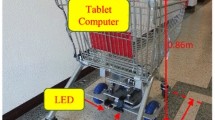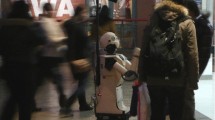Abstract
Intellectualization of life is a general tendency due to the proliferation of technology and science. Based on this concept, this paper presents multi-group localization algorithms and detection algorithms for multi-group service robot system (MGSR). Shopping cart problem is considered as an exemplary multi-group service robot system. The MGSR is designed to provide users with co-service by multiple carts and allows multiple users operation simultaneously. In MGSR, a cart carrying personal belongings of the user follows the user automatically and provides real-time position information to the user. To fulfill estimating the location of MGSR, hybrid external localization algorithm based on combination of QR location information and ZigBee location estimate is proposed. To detect and track a cart by another cart with LRF, we define cart features in LRF data and employ a support vector data description method. Recognition of user–cart groups in MGSR is realized by ZigBee blind nodes on the cart. We verified the feasibility of the proposed algorithms for MGSR through three experiment trials.




























Similar content being viewed by others
References
Meng QH, Sun YC, Cao ZL (2000) Adaptive extended Kalman filter (AEKF)-based mobile robot localization using sonar. Robotica 18(05):459–473
Hsu CH, Yu CH (2009) An accelerometer based approach for indoor localization. In: Proceedings of symposia and workshops on UIC-ATC Ubiquitous, autonomic and trusted computing, pp 223–227
Hijikata S, Terabayashi K, Umeda K (2009) A simple indoor self-localization system using infrared LEDs. In: Proceedings of IEEE Conf. on networked sensing systems, pp 1–7
Haverinen J, Kemppainen A (2009) Global indoor self-localization based on the ambient magnetic field. Robotics Auton Syst 57(10):1028–1035
Kim D, Lee D et al (2014) Artificial landmark-based underwater localization for AUVs using weighted template matching. Intell Serv Robotics 7(3):175–184
Biswas J, Veloso M (2012) Depth camera based indoor mobile robot localization and navigation. In: Proceedings of IEEE conf. on robotics and automation (ICRA), pp 1697–1702
Gezici S, Tian Z et al (2005) Localization via ultra-wideband radios: a look at positioning aspects for future sensor networks. Signal Process Mag IEEE 22(4):70–84
Sanpechuda T, Kovavisaruch L (2008) A review of RFID localization: applications and techniques. In: Proceedings of IEEE conf. on electrical engineering/electronics, computer, telecommunications and information technology, pp 769–772
Hu JS, Chan CY, Wang et al (2011) Simultaneous localization of a mobile robot and multiple sound sources using a microphone array. Adv Robotics 25(1–2):135–152
Surmann H, Nüchter A, Hertzberg J (2003) An autonomous mobile robot with a 3D laser range finder for 3D exploration and digitalization of indoor environments. Robotics Auton Syst 45(3):181–198
Raghavan AN, Ananthapadmanaban H et al (2010) Accurate mobile robot localization in indoor environments using bluetooth. In: Proceedings of IEEE conf. on robotics and automation (ICRA), pp 4391–4396
Paul AS, Wan EA (2008) Wi-Fi based indoor localization and tracking using sigma-point Kalman filtering methods. In: Proceedings of IEEE/ION conf. on position, location and navigation symposium, pp 646–659
Gai S, Jung EJ, Yi BJ (2014) Localization algorithm based on Zigbee wireless sensor network with application to an active shopping cart. In: Proceedings of IEEE/RSJ Conf. on intelligent robots and systems, pp 4571–4576
Bona B, Carlone L et al (2014) Supervision and monitoring of logistic spaces by a cooperative robot team: methodologies, problems, and solutions. Intell Serv Robotics 7(4):185–202
Diosi A, Kleeman L (2004) Advanced sonar and laser range finder fusion for simultaneous localization and mapping. In: Proceedingsof IEEE/RSJ conf. on intelligent robots and systems, pp 1854–1859
Kim HH, Ha KN et al (2009) Resident location-recognition algorithm using a Bayesian classifier in the PIR sensor-based indoor location-aware system. Syst Man Cybern Part C Appl Rev IEEE Trans 39(2):240–245
Luo RC, Chen O (2013) Wireless and pyroelectric sensory fusion system for indoor human/robot localization and monitoring. Mechatron IEEE/ASME Trans 18(3):845–853
Ji Y, Yamashita A, Asama H (2015) RGB-D SLAM using vanishing point and door plate information in corridor environment. Intell Serv Robotics 8(2):105–114
Schmitt T, Hanek R et al (2002) Cooperative probabilistic state estimation for vision-based autonomous mobile robots. Robotics Autom IEEE Trans 18(5):670–684
Rone W, Ben-Tzvi P (2013) Mapping, localization and motion planning in mobile multi-robotic systems. Robotica 31(01):1–23
Jeong D, Lee KIJU (2013) Directional RSS-based localization for multi-robot applications. In: Proceedings of WSEAS conf. on signal processing, robotics, and automation
Franchi A, Oriolo G, Stegagno P (2010) Probabilistic mutual localization in multi-agent systems from anonymous position measures. In: Proceedings of IEEE conf. on decision and control (CDC), pp 6534–6540
Roumeliotis S, Bekey GA (2002) Distributed multirobot localization. Robotics Autom IEEE Trans 18(5):781–795
Dellaert F, Kipp A, Krauthausen P (2005) A multifrontal QR factorization approach to distributed inference applied to multirobot localization and mapping. In: Proceedings of the national conference on artificial intelligence, pp 1261–1266
Dedeoglu G, Sukhatme GS (2000) Landmark-based matching algorithm for cooperative mapping by autonomous robots. Distrib Auton Robotic Syst 4:251–260
Burgard W, Moors M et al (2000) Collaborative multi-robot exploration. In: Proceedings of IEEE conf. on robotics and automation, pp 476–481
Rekleitis IM, Dudek G, Milios EE (2000) Graph-based exploration using multiple robots. Distrib Auton Robotic Syst 4:241–250
Schultz AC, Parker LE (eds) (2003) Multi-robot systems: from swarms to intelligent automata, vol II. Springer, Netherlands
Arai T, Pagello E, Parker LE (2002) Editorial: advances in multi-robot systems. IEEE Trans Robotics Autom 18(5):655–661
Gai S, Oh SM, Yi BJ (2015) ASC localization in noisy environment based on wireless sensor network. Intell Serv Robotics 8(4):1–13
Fu G, Corradi P, Menciassi A, Dario P (2011) An integrated triangulation laser scanner for obstacle detection of miniature mobile robots in indoor environment. Mechatron IEEE/ASME Trans 16(4):778–783
Arras KO, Mozos ÓM, Burgard W (2007) Using boosted features for the detection of people in 2d range data. In: Proceeding of IEEE Conf. on Robotics and Automation, pp 3402–3407
Jung EJ, Lee JH, Yi BJ et al (2014) Development of a laser-range-finder-based human tracking and control algorithm for a marathoner service robot. Mechatron IEEE/ASME Trans 19(6):1963–1976
SemwalVB Katiyar SA, Chakraborty R, Nandi GC (2015) Biologically-inspired push recovery capable bipedal locomotion modeling through hybrid automata. Robotics Auton Syst 70:181–190
Tax DM, Duin RP (1999) Support vector domain description. Pattern Recognit Lett 20(11):1191–1199
Duda RO, Hart PE, Stork DG (2012) Pattern classification. Wiley
Acknowledgments
This work is supported by the Technology Innovation Program (10040097) funded by the Ministry of Trade, Industry and Energy Republic of Korea (MOTIE, Korea), supported by the Technology Innovation Program (10049789, Steering and driving mechanism for Cardio-vascular intervention procedure) funded By the Ministry of Trade, Industry & Energy (MI, Korea), supported by the Technology Innovation Program (10052980, Development of microrobotic system for surgical treatment of chronic total occlusion) funded By the Ministry of Trade, Industry & Energy (MI, Korea), and supported by Mid-career Researcher Program through NRF grant funded by the MEST (NRF-2013 R1A2A2A01068814). This work performed by ICT based Medical Robotic Systems Team of Hanyang University, Department of Electronic Systems Engineering was supported by the BK21 Plus Program funded by National Research Foundation of Korea (NRF).
Author information
Authors and Affiliations
Corresponding author
Rights and permissions
About this article
Cite this article
Gai, S., Jung, EJ. & Yi, BJ. Multi-group localization problem of service robots based on hybrid external localization algorithm with application to shopping mall environment. Intel Serv Robotics 9, 257–275 (2016). https://doi.org/10.1007/s11370-016-0198-1
Received:
Accepted:
Published:
Issue Date:
DOI: https://doi.org/10.1007/s11370-016-0198-1




